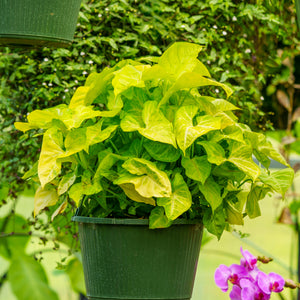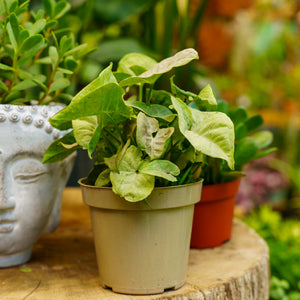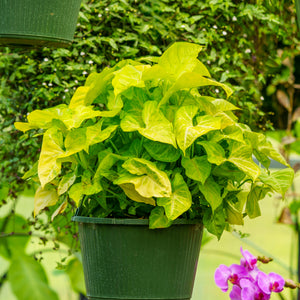The Syngonium Guide
Syngonium, commonly called arrowhead vine or arrowhead plant, is a fast-growing and versatile houseplant admired for its arrow-shaped leaves, trailing or climbing habit, and colorful foliage. Native to Central and South America, syngoniums bring a lush, tropical feel to indoor spaces. With cultivars ranging from deep greens to bright pinks and creamy variegation, syngonium is perfect for hanging baskets, decorative pots, or climbing displays.
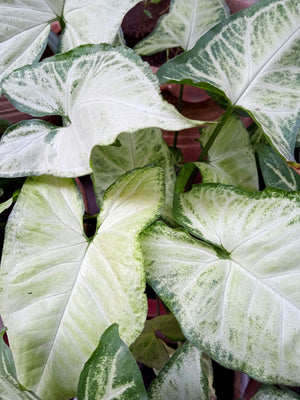
About
Syngonium belongs to the Araceae family and is closely related to philodendrons and pothos. The species most often grown indoors is Syngonium podophyllum, which develops from a compact rosette into a vining or climbing specimen over time. Its foliage transforms in shape as the plant matures—juvenile leaves are arrow-shaped, while mature leaves may become lobed or divided.
Popular varieties include:
- 'White Butterfly', known for its creamy white leaves edged in soft green.
- 'Neon Robusta', which adds bold, rosy pink tones to foliage collections.
- 'Albo Variegatum', prized for its dramatic splashes of white variegation.
- Syngonium wendlandii 'Black Velvet', featuring velvety deep green leaves with silver veins.
- 'Dazzle Color', a rare cultivar with a mosaic of pink, cream, and green tones.
These plants adapt well to various lighting conditions and tolerate occasional neglect, making them popular among both beginner and experienced indoor gardeners.

PLANTING
Planting syngonium indoors is simple, as they thrive in typical houseplant conditions:
- USDA Hardiness Zones: Hardy outdoors only in Zones 10–11. Grown indoors as a houseplant in all zones.
- Soil: Use a loose, well-draining potting mix. A blend of peat moss, perlite, and coco coir works well.
- Sunlight: Prefers bright, indirect light. Tolerates low light but variegated varieties may lose color in dim conditions.
- Pot Size: Choose a container with good drainage. Repot every 1–2 years as the roots fill out.
- Humidity: Thrives in moderate to high humidity. Occasional misting or a pebble tray helps in dry environments.
When potting, position the plant at the same depth it was previously growing, gently firm the soil around the roots, and water thoroughly.

CARE
Syngoniums are easy to care for but benefit from consistent attention to watering and pruning:
- Watering: Allow the top inch of soil to dry out between waterings. Avoid letting the soil become soggy, as this may lead to root rot.
- Fertilizing: Feed monthly during the growing season (spring and summer) with a balanced liquid fertilizer diluted to half strength.
- Pruning: Trim back leggy growth to encourage a bushier habit. Cut just above a leaf node to stimulate branching.
- Support: As the plant matures, it may climb. Provide a moss pole or trellis if desired.
- Pests: Watch for spider mites and aphids. Wipe leaves regularly and treat with neem oil or insecticidal soap as needed.
Rotate the plant periodically to promote even growth and keep the foliage full and symmetrical.
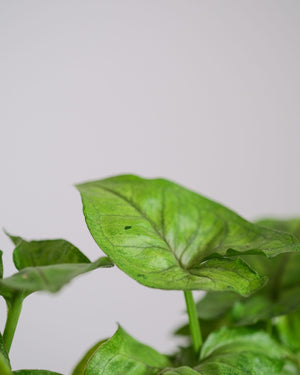
HOW TO USE
Syngonium is a decorative houseplant that suits a variety of interior styles and plant arrangements:
- Hanging Baskets: Let vines trail gracefully over the sides for a cascading effect.
- Bookshelves and Plant Stands: Add a touch of greenery and height with colorful varieties like 'Neon Robusta' or 'Dazzle Color'.
- Terrariums: Younger plants or compact cultivars work well in high-humidity enclosures.
- Climbing Displays: Train on moss poles or bamboo stakes for vertical interest.
- Companion Plants: Pair with pothos, philodendron, or calathea for a lush, mixed foliage display.
Syngonium's vibrant leaves and adaptable nature make it a standout choice for enhancing indoor environments.
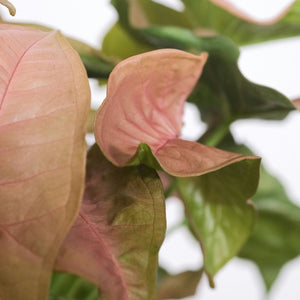
COMMON QUESTIONS
- How to propagate syngonium? Syngonium is easily propagated through stem cuttings. Cut below a node and place the cutting in water or moist potting mix until roots develop.
- Are syngonium toxic to cats? Yes, syngonium is toxic to cats if ingested. It can cause mouth irritation, drooling, and vomiting.
- Are syngonium toxic to dogs? Yes, syngonium is also toxic to dogs and should be kept out of reach of pets.
- Do syngonium climb? Yes, mature syngonium will naturally climb when given support such as a moss pole or trellis.
- Why is my syngonium turning yellow? Yellowing leaves are usually a sign of overwatering or poor drainage. Ensure the soil dries slightly between waterings and the pot has adequate drainage holes.
Conclusion
Syngonium is a charming and colorful houseplant that offers flexibility, beauty, and easy care. Its evolving leaf shapes and climbing growth habit make it a dynamic addition to any plant collection. Whether trailing from a shelf or trained to grow upward, syngonium brings a tropical touch and thrives in a variety of indoor settings.
The Syngonium Collection
Sold Out
Sold Out
Sold Out
Sold Out
Sold Out
Sold Out

